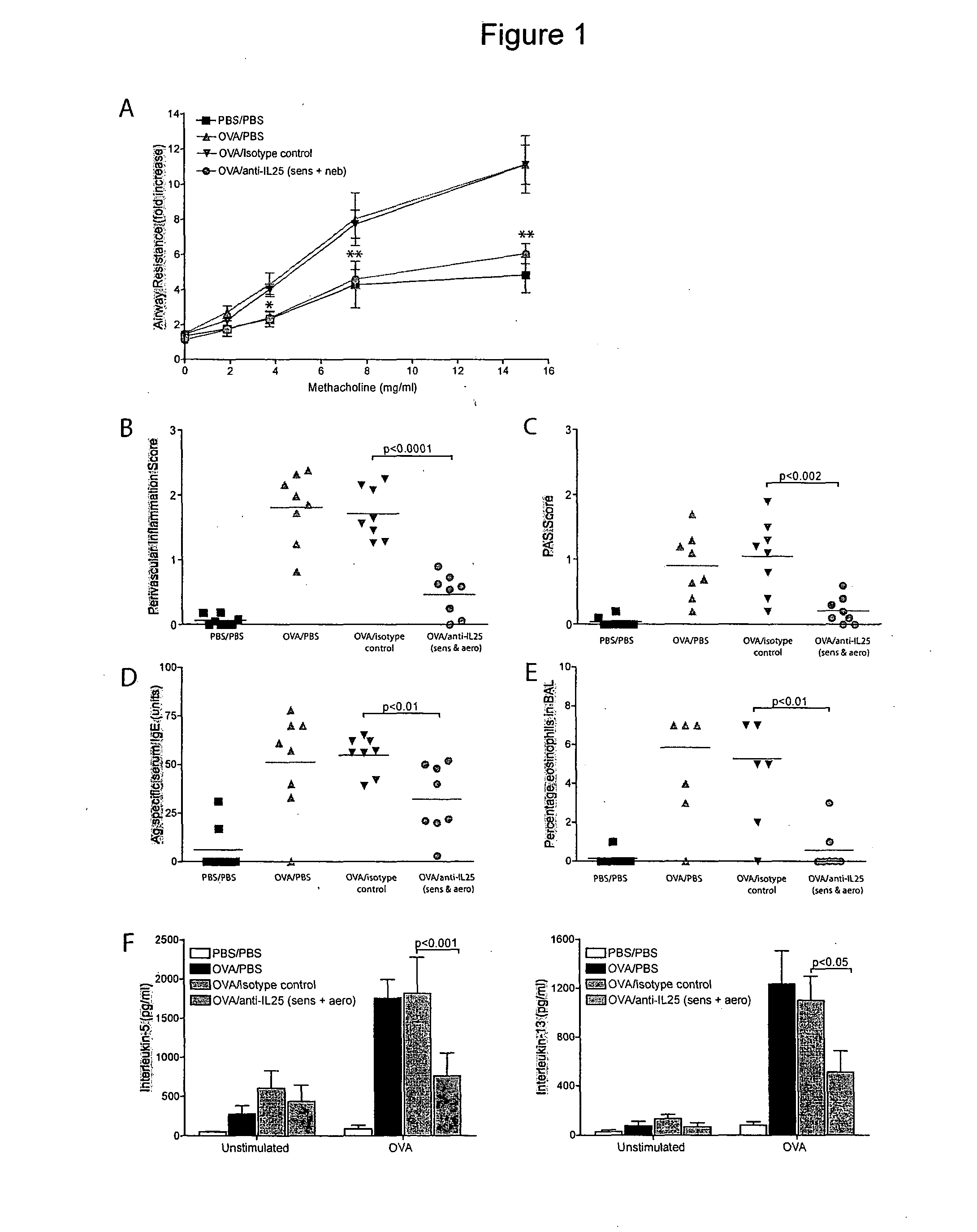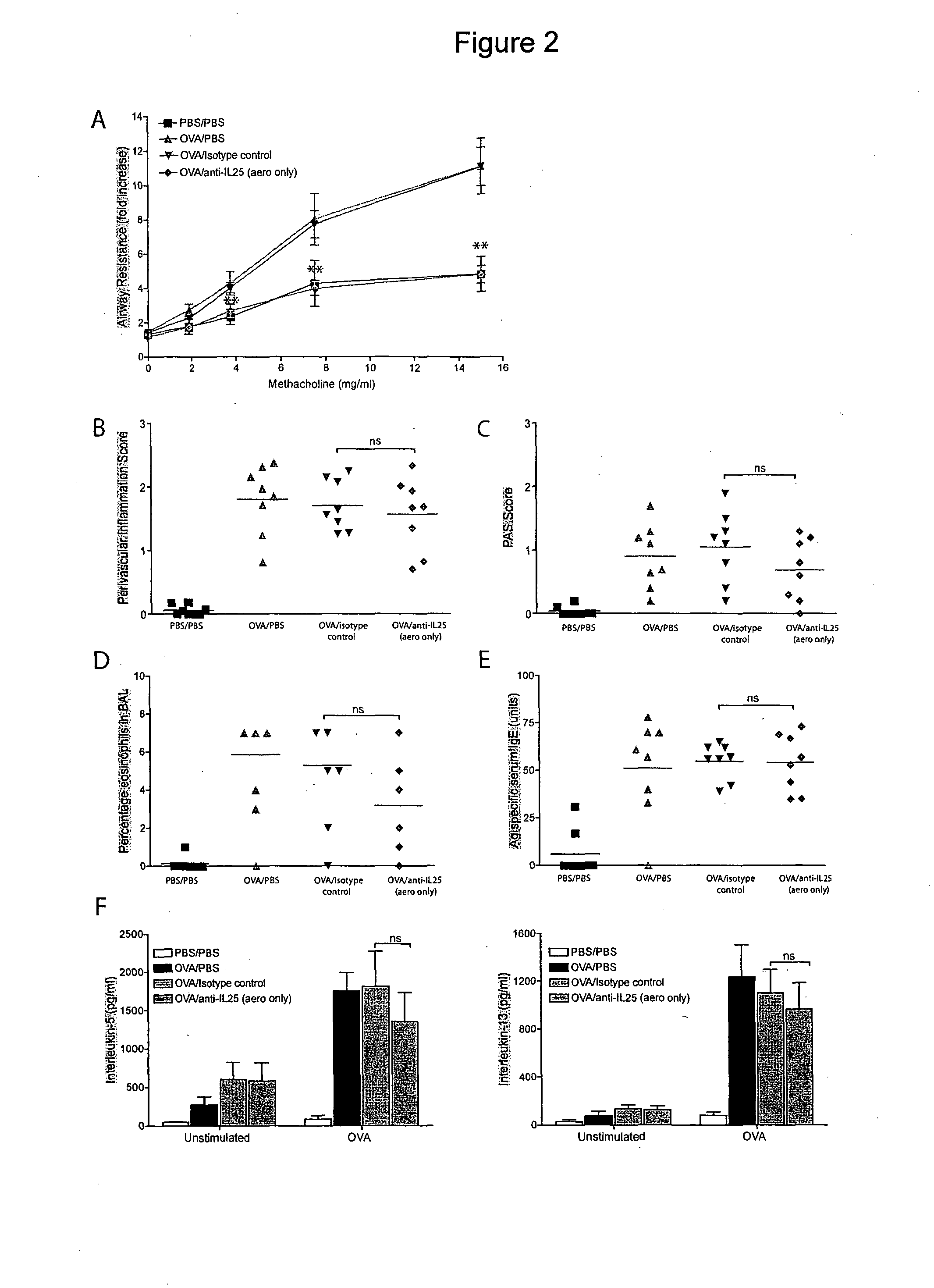Antibodies Against IL-25
a technology of antibodies and il-25, applied in the field of antibodies, to achieve the effect of reducing the number of immunogenic epitopes, and achieving the greatest degree of conservation
- Summary
- Abstract
- Description
- Claims
- Application Information
AI Technical Summary
Benefits of technology
Problems solved by technology
Method used
Image
Examples
example 1
Generation of Antibodies Against IL-25
[0151]A large panel of antibodies, generated in il25− / − mice immunised against murine IL-25 (R&D Systems), was screened. One of these anti-IL-25 antibodies (2C3) was found to inhibit both the interaction between rmIL-25 and a soluble mIL-25R-Fc fusion protein dose dependently and IL-25-dependent production of IL-13 by primary mouse non-B, non-T cells in an in vitro bioassay. The antibody also inhibited the interaction between hIL-25 and a soluble hIL-25R-Fc fusion. The combination of these properties was investigated further in in vivo systems to demonstrate usefulness in the treatment of asthma.
example 2
Experimental Model of Allergic Asthma
[0152]BALB / c mice were first sensitized with the antigen ovalbumin (OVA), before being challenged with aerosolised OVA. Sensitised and challenged BALB / c mice developed a distinctive asthma phenotype. This was characterised by increased AHR following exposure to the provocative agent methacholine, eosinophil infiltration of the airways, goblet cell hyperplasia and serum IgE secretion, as compared to control BALB / c mice challenged with PBS (FIG. 1).
[0153]By contrast administration of anti-IL-25 mAb prior to each sensitization and aerosolization with OVA resulted in a marked abrogation in AHR following challenge with aerosolised methacholine, with resistance values comparable to the PBS control mice (FIG. 1A). Administration of an isotype-matched control mAb did not suppress AHR (FIG. 1A).
[0154]The anti-IL-25 mAb also significantly reduced the levels of cellular infiltration around the lung vasculature (FIGS. 1B and 3A), goblet cell hyperplasia in t...
example 3
Administration Prior to Challenge
[0168]We also assessed whether the anti-IL-25 mAb was effective when administered only prior to the OVA aerosolisation challenge. Treatment with the anti-IL-25 mAb dramatically reduced the airways resistance induced by methacholine provocation even when it was given later in the response (FIG. 2A). By contrast, administration of the control isotype-matched mAb did not abrogate AHR.
[0169]Significantly, analysis of lung histology sections showed no significant changes in the levels of cellular infiltrate around blood vessels (FIG. 2B) or airway goblet cell hyperplasia (FIG. 2C) between anti-IL-25 mAb treated mice and the OVA challenged BALB / c controls or the isotype-matched mAb treated controls.
[0170]Furthermore, there was no observable reduction in the proportion of eosinophils in the BAL fluid (FIG. 2D) or the levels of antigen-specific serum IgE (FIG. 2E), following anti-IL-25 mAb administration. Strikingly, the levels of the type-2 cytokines IL-5 a...
PUM
| Property | Measurement | Unit |
|---|---|---|
| tidal volume | aaaaa | aaaaa |
| nucleic acid | aaaaa | aaaaa |
| composition | aaaaa | aaaaa |
Abstract
Description
Claims
Application Information
 Login to View More
Login to View More - R&D
- Intellectual Property
- Life Sciences
- Materials
- Tech Scout
- Unparalleled Data Quality
- Higher Quality Content
- 60% Fewer Hallucinations
Browse by: Latest US Patents, China's latest patents, Technical Efficacy Thesaurus, Application Domain, Technology Topic, Popular Technical Reports.
© 2025 PatSnap. All rights reserved.Legal|Privacy policy|Modern Slavery Act Transparency Statement|Sitemap|About US| Contact US: help@patsnap.com



